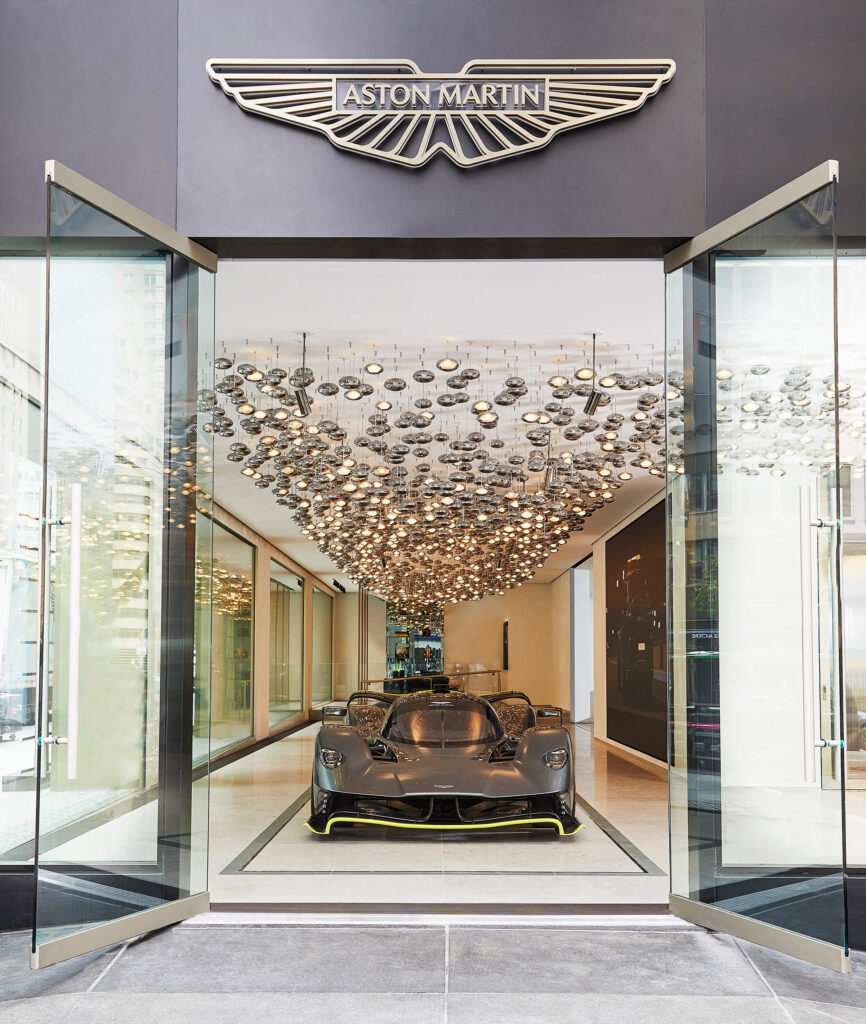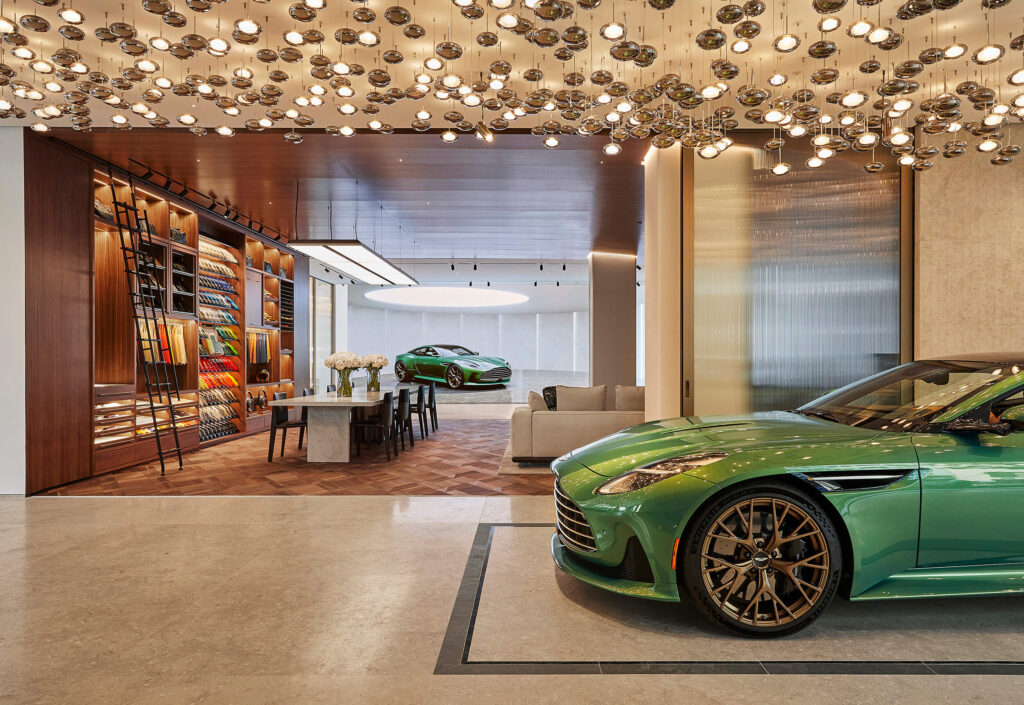
Despite dizzying advances in digital design and AI-generated imaging, a pencil or biro sketch remains the most efficient means of conveying a designer’s vision at Aston Martin’s Design Studio in Gaydon.
“It’s fast, and a way of expressing and communicating with the other people in the team,” says Miles Nurnberger.
As Aston Martin’s Director of Design, Miles is responsible for overseeing these initial creative explorations. And it’s not just for tradition’s sake. Sketching provides the essential building blocks for character development, which proves crucial throughout the design journey. As Miles explains: “If a sketch has a strong character, it can survive the production process.”

One exemplary model that embodies this philosophy is the DB12, the latest addition to the 75-year-long DB bloodline, which surpasses the grandeur of its predecessors to claim the title of the world’s first ‘Super Tourer’.
With a wider, taller grille and a more muscular physique that belies its power, DB12’s bold and assertive exterior marks a significant shift in character for the brand. But there remains an enduring design principle at its core, where proportion meets perfection. The Golden Ratio, as observed in nature and throughout history, sits at the heart of every Aston Martin.
Chief Designer Julian Nunn leads the clay modelling team that selects the most captivating sketches and brings them to life in physical form. With a focus on proportion, Julian understands the significance of finding inspiration in nature’s inherent balance.




“The fact that nature has grown this organic thing, which is perfect in a certain curve, means that we should then look at that and use it,” he says.
Using various sculpting techniques to shape and refine the exterior surfaces of vehicle models, clay modellers enable the design team to evaluate the concept’s visual appeal, proportions and aerodynamic performance.
“You cannot beat having something physical – to touch it, to play with it,” Julian adds. “Sometimes there are problems on the surface but you have to touch them, and over the years know if it’s right or wrong. You can’t do that with a computer or an AI.”
Very often it is the nuance of craftsmanship that will win over the brute rationality of technology. “Some of the things that are wrong can be right. The programmes that we use, Alias and Blender, can build something that is mathematically perfect but it will look static. It will look a bit what we call ‘wooden’, it won’t look organic, it won’t look natural.”
Finding automotive beauty through these hands-on techniques reflects an appreciation for materiality cultivated throughout the studio. Aston Martins are designed to be touched, felt and heard. It’s this physical and sensory interaction that the team transfers into an unparalleled driving experience for the customer.
The challenge for Leighanne Earley, Creative Director of Interiors, was how to reinvent the cockpit of DB12 while creating classicism as well. “When we were doing this split personality character look, we started thinking about Apple meets Hermès – the racetrack to the opera,” she explains.
It was out with the old proportion and in with the new – and the result is contemporary and clean. Beyond the luxury craftsmanship and the finest materials that customers have come to expect from Aston Martin, the DB12’s interior is decidedly driver-centric with the perfect blend of digital and analogue controls.
“We’re moving into the next level of emotion with user interface (UI),” Leighanne adds. “How can a UI and a user experience (UX) be emotional? How can we look at how it is integrated and hidden?”
Cue a state-of-the-art Aston Martin infotainment system that forms the centrepiece of the all-new interior, atop a sloping ‘waterfall’ centre console.


Pushing new technology, while maintaining that all important level of tactility is paramount within the Aston Martin Design Studio, as is harnessing high-tech to accelerate the design process.
Aston Martin’s Design Visualisation Manager, Stuart Boote, will take imagery and technical models to the next level by visualising new designs in a three-dimensional virtual space.
These are explored through augmented reality headsets in design reviews to help exterior and interior designers as their concept evolves.
“It can be at a really early stage, when the digital model that we have is very rough, with quite basic surfaces,” Stuart says. “But because it is accurate, and the computer-aided design (CAD) team have modelled everything to the right size, it is actually a really good representation.”

Q New York, Aston Martin’s new ultra-luxury flagship location on 450 Park Avenue and 57th Street, will become the ultimate destination for customers seeking a similarly immersive experience along their own customisation journey. “It is the flagship for our new way of interacting with our bespoke customers,” says Marek Reichman, Executive Vice President and Chief Creative Officer. “The showroom is not just about warmth and depth of luxury, it’s about high-tech as well.”
Q New York serves as a showcase and launch venue for Aston Martin’s latest and greatest products in North America, from unique special builds to limited-edition models and newcomers to Aston Martin’s portfolio. Perhaps the most exciting feature is a 10.5 metre x 3.5 metre ultra-high definition LED wall capable of providing a 360-degree view of any Aston Martin in real-life size. A visualisation system that is so photorealistic, Marek claims, you will not be able to tell it’s not a car.
“For each car that is being presented, there will be a premade digital presentation of the car that sits in a virtual world – in a metaverse effectively,” he explains. “You’ll be able to see your car driving on a planet that doesn’t exist, in front of a house that doesn’t exist, driving into a garage that doesn’t exist, so you can imagine yourself going on that journey.”
But, once again, the brand hasn’t lost sight of materiality, even when interacting with the virtual in this cutting-edge way.
“It is absolutely fundamental to who we are because ultimately, the digital environment is relatively cold,” Marek says. “When you sit in our interiors and you stare at one of our cars there is a physical interaction that happens.”
Marek describes the specification lounge itself as an “apothecary” due to the sheer amount of choices of materials, colours and finishes contained within its walls. “All of the things you’ve ever imagined for an Aston Martin are displayed physically. So, already it’s a treasure trove of colour, texture and smell as well.”
Those with an appreciation for the intersection of craftsmanship and technology will delight in the lounge’s projector: a beautiful table-top system with cleverly integrated plates that scan the customer’s selected leathers, stitches or colourways onto their virtual exterior or interior.
“The materiality and real items are really important as we get more digital in our world,” says Marek. “It’s the LP that’s turning on a Linn Sondek turntable versus my mp3 player. They’re both providing music, but one is extra special.”
Ultimately, Marek believes it’s about recognising that the human drive to bring something new into the world will always be the engine for change and innovation.
“If you’re not emotionally engaged, you won’t have a product that people desire.”
































